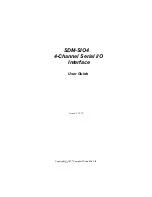
Parameter
Description
Threshold
Threshold sets the input signal level above which dynamic range
compression takes place. Everything above the threshold will be
brought down in volume. Range: -60dB to +12dB
Ratio
Sets the ratio of input signal level to output signal level, or
“how much” compression will be applied. Range: 1:1 to ×:1
Post Gain
Amplifies the signal after it has been compressed to bring up the
volume. Range -60dB to +60dB
Attack Time
Controls how quickly the gain is turned down after the signal
exceeds the threshold. Range .1ms to 500ms
Release Time
Controls how fast the gain is returned to its normal setting after the
signal has fallen below the threshold.
Range: 50ms to 3000ms
Pre-Delay
Allows the use of slower attack times without missing signal peaks.
Range: 0ms to 3 ms
Input Meter
Allows you to monitor the strength of the input signal.
Gain Reduction Meter
Shows the amount of gain reduction being applied.
5 - Effects
Core Effects Descriptions
E-MU PCIe Digital Audio Systems
69
again. An attack setting of about 10 milliseconds will delay the onset of compression
long enough to preserve the attack transients in guitar, bass or drums while allowing
the sustain portion of the sound to be compressed. Longer release times are generally
used to reduce the so called “pumping” effect as the compressor turns on and off.
Don’t make the release time too long, however, or the compressor won’t have time to
recover for the next pluck or hit. In general, the attack and release controls are used to
smooth out the action of the compressor, but they can also be used to create special
effects.
The Pre-Delay parameter lets the level detector “look into the future” up to 4 milli-
seconds in order to anticipate upcoming peaks in the signal. This is accomplished of
course, by inserting delay into the signal path. This lookahead technique allows the use
of slower attack times without missing signal peaks. This parameter is especially
effective on drums and percussion.
The Input Meter allows you to monitor the strength of your input signal. Always try to
boost the signal before the compressor if you can.
The Compression Meter shows the amount of gain reduction being applied. Since this
meter displays how much the gain is being turned
down
, the meter moves from right to
left, instead of left to right like a normal meter.
















































